CONSTELLATIONS
A constellation is a group of stars you can see in one area of the sky at night. Constellations are named after animals, mythological characters and scientific instruments. Constellations can be seen only at nightime and as the earth turns you can see different constellations.
Southern Cross [Crux]
Crux, or the Southern Cross, is a constellation in the southern sky. It is one of the best known constellations in the southern hemisphere, and easily recognizable for its cross-shape, the Southern Cross, formed by its four brightest stars.

Orion
Story: Orion is the master of the winter skies. He lords over the heavens from late Autumn to early spring, with his hunting dog Sirius trailing at his feet.
The mythic tales of Orion go as far back as the Hittites, who lived from the Second Millenium BC to around 1200 BC.
One story from this culture tells of Orion's death. Here he is called Aqhat, and was a handsome and famous hunter. The Battle-Goddess Anat fell in love with Aqhat, but when he refused to lend her his bow, she sent another man to steal it. This chap bungled the job, and wound up killing Aqhat and dropping the bow into the sea. This is said to explain the astronomical fact that Orion and the Bow (an older version of the constellation) drops below the horizon for two months every spring.

Scorpius
Scorpius is one of the oldest constellations known - possibly even one of the original six signs of the zodiac. The constellation was once much larger, but the western portion representing the claws of the scorpion was given to Libra.

Saucepan
In the southern hemisphere, Orion passes high across summer evening skies, upside down. Instead of the mythical figure, many see the constellation as a saucepan framed by a quadrilateral of bright stars.

Cassiopeia
Story: Cassiopeia was the wife of Cepheus, the Ethiopian king of Joppa (now known as Jaffa, in Israel), and the mother of Andromeda. The queen was both beautiful and vain, and the story of how her vanity caused great distress is told in relation to the constellation Andromeda.
After promising her daughter in marriage to Perseus, Cassiopeia had second thoughts. She convinced one of Poseidon's sons, Agenor, to disrupt the ceremony by claiming Andromeda for himself. Agenor arrived with an entire army, and a fierce struggle ensued.
In the battle Cassiopeia is said to have cried "Perseus must die". At any rate it was Perseus who was victorious, with the help of the Gorgon's head.
Perseus had recently slain Medusa, the Gorgon, and had put its head in a bed of coral. He retrieved the head and waved it in midst of the warring wedding party, instantly turning them all to stone. In the group was both Cepheus and Cassiopeia.

Leo
Leo is a fairly compact constellation and, unlike so many other constellations, it is easily recognisable. An Easy way to spot Leo is to look for a backwards question mark in the sky, which represents the head and front of the body.

Ursa Major
Story: The two stars on the end of the handle of the big dipper are robins. Sparrow and Crow are their names. The two birds were hungry and didn't save any food for the winter. Then Crow said to Sparrow, "we should go into a bear cave and kill a bear while it is hibernating." So Sparrow and Crow went off to find a bear. They found a bear cave and saw the bear Ursa Major. When they were about to kill it the bear woke up. Ursa Major was scared. Sparrow and Crow chased the bear for one year until they were tired of running. Then Crow threw an arrow and killed the bear. Blood splattered all over the bird's bodies and made their chests red. That is the myth of why robins have red chests.

